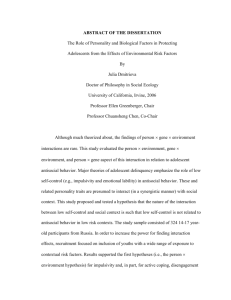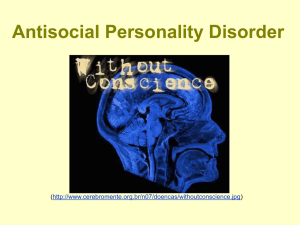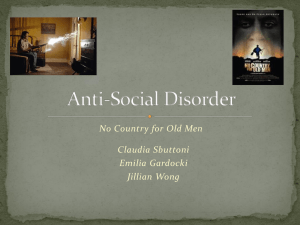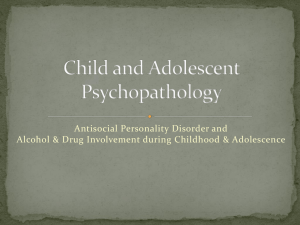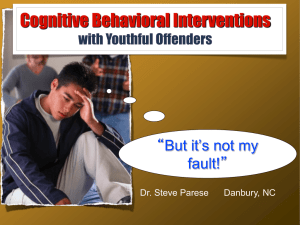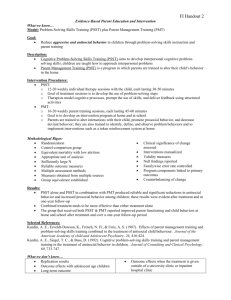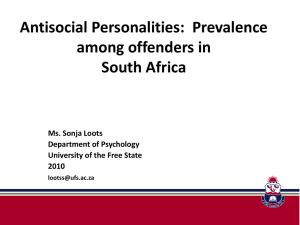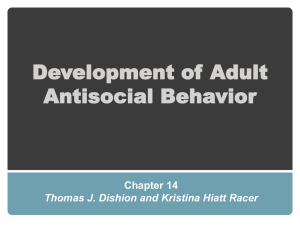Behavior of conduct disordered children in interaction with each
advertisement
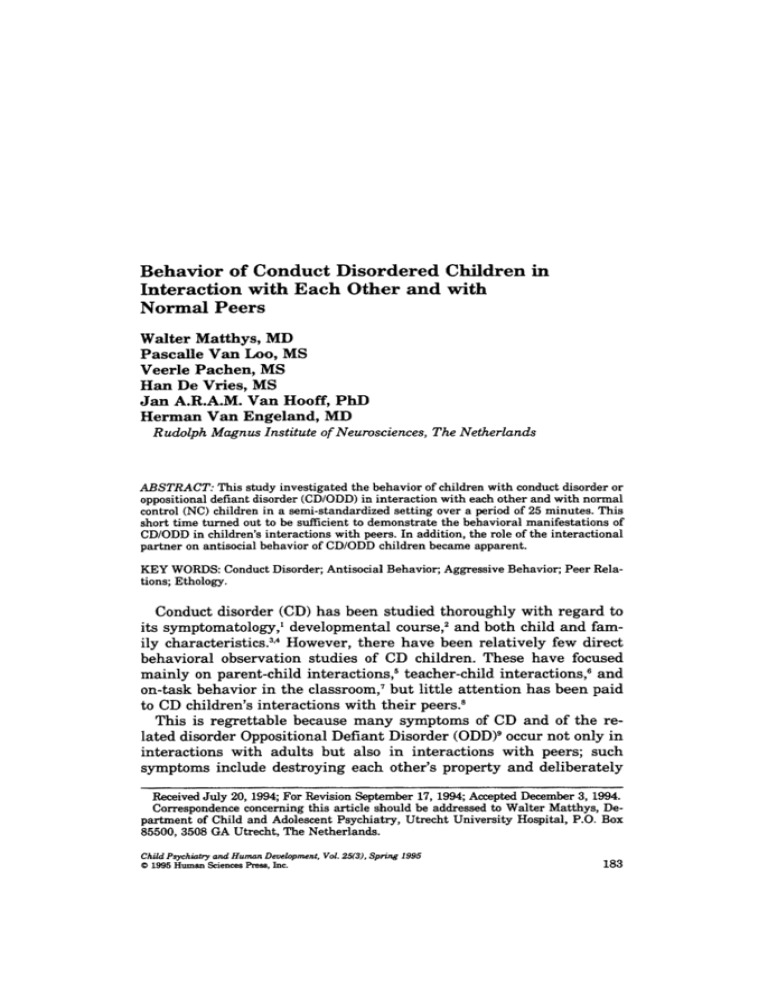
Behavior of Conduct Disordered Children Interaction with Each Other and with Normal Peers in Walter Matthys, MD Pascalle Van Loo, MS Veerle P a c h e n , MS H a n De Vries, MS Jan A.R.A.M. Van Hooff, P h D H e r m a n V a n Engeland, MD R u d o l p h Magnus Institute o f Neurosciences, The Netherlands ABSTRACT: This study investigated the behavior of children with conduct disorder or oppositional defiant disorder (CD/ODD) in interaction with each other and with normal control (NC) children in a semi-standardized setting over a period of 25 minutes. This short time turned out to be sufficient to demonstrate the behavioral manifestations of CD/ODD in children's interactions with peers. In addition, the role of the interactional partner on antisocial behavior of CD/ODD children became apparent. KEY WORDS: Conduct Disorder; Antisocial Behavior; Aggressive Behavior; Peer Relations; Ethology. Conduct disorder (CD) has been studied thoroughly with regard to its symptomatology,I developmental course,2 and both child and family characteristics.3"4 However, there have been relatively few direct behavioral observation studies of CD children. These have focused mainly on parent-child interactions,5 teacher-child interactions,6 and on-task behavior in the classroom,7 but little attention has been paid to CD children's interactions with their peers, s This is regrettable because many symptoms of CD and of the related disorder Oppositional Defiant Disorder (ODD)s occur not only in interactions with adults but also in interactions with peers; such symptoms include destroying each other's property and deliberately Received July 20, 1994; For Revision September 17, 1994; Accepted December 3, 1994. Correspondence concerning this article should be addressed to Walter Matthys, Department of Child and Adolescent Psychiatry, Utrecht University Hospital, P.O. Box 85500, 3508 GA Utrecht, The Netherlands. ChildPsychiatryand HumanDevelopment, Vol.25(3),Spring 1995 © 1995HumanSciencesPress,Inc. 183 184 Child Psychiatry and Human Development doing things that annoy others. 1° Patterson" found that these and other "aversive" behaviors occur at a high rate (mean of .82 per minute) at home in child-parent and child-sibling interactions of 9 to 10 year old antisocial children referred for treatment. In this study we investigated whether it is possible to identify the behavioral manifestation of CD and ODD in peer-peer interactions over a short period of time. Kazdin TM draws a distinction between low-frequency, highintensity antisocial behaviors (e.g., fighting, destroying) and high-frequency, low-intensity antisocial behaviors (e.g., demanding, denigrating). The CD and ODD children investigated in our study were expected to show over a short period of time their high-frequency, low-intensity antisocial behaviors rather than their low-frequency, high-intensity antisocial behaviors. Behavior can be studied both in natural settings (at home, in the classroom) and in standardized settings (at the clinic, in the laboratory). Although independent observations in vivo may be the richest source of information, they are time consuming, expensive and inconvenient. Also, in such observations one investigates not only the behavioral manifestation of the child's own disorder but also the effect of situational variables that affect his or her behavior. ~3By contrast, in standardized settings these context factors are kept to a minimum. In this study, we used a semi-standardized procedure in which we investigated both the behavioral manifestations of CD/ODD and the effect of the interactional partner on CD/ODD children's behavior. The samples involved in the study were an inpatient psychiatric group of 10 year old CD/ODD children (CD) and a normal control group (NC) from a regular school. First, behavioral differences between dyads of CD children (CD-CD) and dyads of NC children (NCNC) were studied while children were playing a competitive game for ten minutes. It was hypothesized that CD children would show both more active antisocial behavior, i.e., antisocial initiatives, and more reactive antisocial behavior, i.e., antisocial behavior in response to behavior of the partner, than do NC children. Secondly, triads were formed: either one NC child joined two CD children (CD-CD-NC) or one CD child joined two NC children (NC-NC-CD); children played a cooperative game for 15 minutes. We expected that CD children would show both more active and more reactive antisocial behavior in their interactions with other CD children than in their interactions with NC children; it has been demonstrated before that children behave more aggressively towards an aggressive peer than towards a Matthys, Van Loo, Pachen, De Vries, Van Hooff, a n d Van E n g e l a n d 185 nonaggressive peer. 14 Fine-grained analyses of behavioral interactions were conducted using ethological methods. Method Subjects The conduct disordered group (CD) consisted of 15 children who met the criteria for either conduct disorder or oppositional defiant disorder as set out in the Diagnostic and Statistical Manual of Mental Disorders (D.S.M.-III-R)? These boys (N = 10; mean age = 10 years 4 months) and girls (N = 5; mean age = 10 years 10 months) were under inpatient psychiatric treatment at Vossevetd, a division of the Department of Child and Adolescent Psychiatry, Utrecht University Hospital. The normal control group (NC) consisted of 15 children who attended a regular school: 10 boys (mean age = 9 years 10 months) and 5 girls (mean age = 10 years 7 months). In order to demonstrate differences between the two groups, both the parent-completed and the teacher-completed forms of the Child Behavior Checklist (CBCL) 15,~swere used. The parent's form was completed by the subjects' primary care-takers, i.e., the educators and parents of the CD and the NC group respectively. The Total Behavior Problem Score reflects overall severity of dysfunction; the difference between the Total Behavior Problem Score for the CD (M = 68.3) and the NC group (M = 12.8) was significant, Mann Whitney, U (15,15)= 1, p < .001. Of the various syndrome scores on the CBCL, the scores on the Aggressive Subscale seemed to be of particular relevance for our study: on the Aggressive Subscale, CD boys (M = 17.9) differed significantly from NC boys (M = 3.3), Mann Whitney, U (10,10)= 11, p < .001, and CD girls (M = 24.2) differed significantly from NC girls (M = 2.6), Mann Whitney, U (5,5) = 0, p < .01. The children's teachers completed the teacher's form (TRF) of the CBCL. TM On the Total Behavior Problem Score, the CD group (M = 59.1) differed significantly from the NC group (M = 12.4), Mann Whitney, U (15,15)= 14.5, p < .001. On the Aggressive Subscale, CD boys (M = 17.2) differed significantly from NC boys (M = 4.3), Mann Whitney, U (10,10)= 16, p < .01, and CD girls (M = 19.0) differed significantly from NC girls (M = 1.4), M a n n Whitney, U (5,5)= 0, p < .01. 186 Child Psychiatry and Human Development Procedures Subjects were taken from the clinic or the regular school by a research assistant and brought to an observation room which was unfamiliar to either group; observations were m a d e between 10.00 h and 15.30. The children played two games: a competitive game and a cooperative game. These two games can be regarded as critical problematic social situations for the population of school children. In the first game, a competitive one, children have to "respond to failure and to success", i.e., two of the six problematic social situations of Dodge, McClaskey and Feldman's Taxonomy of Problematic Social Situations for Children. 17 In the second game, a cooperative one, "social expectations" are involved, i.e., this is another critical problematic social situation. The sessions were videotaped. Before starting each game the rules were explained by a research assistant, after which she left the observation room; in the next room she observed the interactions between the children on a monitor. Each session started with a dyad of CD children (CD-CD) or NC children (NC-NC) playing a competitive game of chance (Bingo) for 10 minutes. In this w a y differences between CD dyads and NC dyads could be studied. Then, in order to study behavioral differences between CD children and NC children in interaction with each other, triads were formed: either one NC child joined two CD children (CD-CD-NC) or one CD child joined two NC children (NC-NC-CD). After a period of habituation and playing together, members of the triads were asked to construct a zoo that each of them would like, using a plan and a large number (195) of animal figures. The latter were divided between the three members. It was obvious from the outset t h a t there were too m a n y figures for the plan; this cooperative game took 15 minutes. Scoring of Behavior The videotapes of the sessions were analyzed afterwards. An observation procedure was used in which the behavior of the children was divided into "active behavior" and "reactive behavior", and was scored accordingly (actor + behavior--~ reactor + behavior). Forty behavioral elements had been identified beforehand (see Appendix) on the basis of earlier ethological studies is and our own observations. These elements were categorized into three main types of behavior: Antisocial behavior, Prosocial behavior (i.e., behavior in- Matthys, Van Loo, Pachen, De Vries, Van Hooff, and Van Engeland 187 tended to benefit the other child), and Other behavior (rest category). Inter-observer reliability of the scoring of behavioral elements was computed between two trained observers; Cohen's k a p p a was .78. TM Results The actor/reactor sequences were converted into matrices showing action and reaction profiles. The action profiles contained all the active behavior of the children. The reaction profiles contained all the reactive behavior of the children in a matrix that showed which action preceded the reaction concerned. The profiles were established by means of the following programs: dBase, ~ SAS 21 and MatMan. = To test differences, the scores of the behavioral elements were summed to obtain scores for the main types of behavior (Antisocial, Prosocial, Other). Differences between CD and NC children were tested with Mann-Whitney U; all results were subjected to one-tail tests (see Table 1). A total of 20 sessions were analyzed. In the dyadic interactions, analyses were conducted for each child separately (i.e., 20 CD children and 20 NC children); in the triadic interactions, children from the same group were treated as one (i.e., 10 CD and 10 NC children). Due to practical problems one session was only partly analyzed. Dyadic Interactions Analyses of active behavior showed that CD children in interaction with each other (CD-CD) initiated significantly more antisocial behavior than NC children in interaction with each other (NC-NC) (54% vs 36%), U (18,20) = 84, p < .05; because in the analyses of active behavior antisocial and prosocial behavior were interdependent, CD children in interaction with each other were also found to initiate less prosocial behavior than NC children in interaction with each other. Analyses of reactive behavior were divided into two groups: behavior following antisocial behavior of the actor and behavior following prosocial behavior of the actor. CD children reacted to antisocial behaviors of other CD children (CD-CD) with significantly more antisocial behavior (33 %) than NC children reacted to antisocial behaviors of other NC children (19 %) (NC-NC) (U (17,18) = 81, p < .01)), b u t not with less prosocial behavior (32 vs 42 %), U (17,18) = 135.5, n.s.. In their reaction to prosocial behavior CD and NC children hardly 18 47 Following prosoeial behavior Antisocial Prosoeial Antisocial Prosocial Active behavior Antisocial Prosocial NC in NC-NC interactions 19 30 NC in NC-CD interactions 13 39 in NC-NC-CD triads CD in CD-NC interactions 15 24 16 43 19 42 36 64 NC in NC-NC-dyads in CD-CD-NC triads CD in CD-CD interactions 29 31 33 32 Reactive behavior Following antisocial behavior Antisocial Prosocial Triadic 54 46 CD in CD-CD dyads Active behavior Antisocial Prosoeial Dyadic Table 1 Percentages of Active and Reactive Antisocial and Prosocial Behavior in Dyadic and Triadic Interactions U = 33.5 U=33.5 U=28.5 U=40 U = 155.5 U = 160 U=81"* U = 135.5 U = 84* U = 84* Mann Whitney U **p<.01 *p<.05 Prosocial Following prosocial behavior of N C or C D Antisocial Prosocial Following antisocial behavior of NC or CD Antisocial Following antisocial behavior of CD or NC Antisocial Prosocial Following prosocial behavior of CD or NC Antisocial Prosocial Reactive behavior of NC 28 54 of NC 28 58 CD of NC 39 52 of NC 34 57 NC of CD 18 49 of CD 21 59 NC in NC-NC-CD triads of CD 60 35 of CD 46 51 CD in CD-CD-NC triads U=29 U=46 U = 18.5" U=40 U = 23* U=33 U = 7.5** U = 19" 190 Child Psychiatry a n d H u m a n Development differed in their antisocial behavior (18 % vs 16 %) (U (18,20) = 155.5, n.s.) or in their prosocial behavior (47 vs 43 %) (U (18,20) = 160, n.s.). Triadic Interactions Analyses of active behavior showed t h a t in CD-CD-NC sessions CD children in interactions with each other (CD-CD) did not differ significantly in their antisocial behavior from CD children in interactions with NC children (CD-NC) (29 % vs 15 %) (U (10,9) = 28.5, n.s.); in prosocial behavior there were no differences either (31% vs 24 %) (U, (10,9) = 40, n.s.). Also, in NC-NC-CD sessions NC children in interactions with each other (NC-NC) did not differ significantly in their antisocial behavior from NC children in interactions with CD children (NC-CD) (19 % vs 13 %) (U (10,9) = 33.5, n.s.); there were no differences in prosocial behavior either (30 % vs 39 %) (U (10,9) = 33.5, n.s.). Analyses of reactive behavior showed t h a t in CD-CD-NC sessions, CD children reacted to antisocial behavior with significantly more antisocial behavior when the actor was a CD child t h a n when the actor was an NC child (60 % vs 28 %) (U (10,9) = 7.5, p < .01); also, they reacted with significantly less prosocial behavior when the actor was a CD child t h a n when the actor was an NC child (35 % vs 54 %) (U (10,9) = 19, p < .05). Also, CD children reacted to prosocial behavior with significantly more antisocial behavior (46 % vs 28 %) (U (10,10) = 23, p < .05) but no less prosocial behavior (51% vs 58 %) (U (10,10) = 33, n.s.) when the actor was a CD child t h a n when the actor was an NC child. In NC-NC-CD sessions, NC children reacted to antisocial behavior with significantly more antisocial-behavior when the actor was an NC child t h a n when the actor was a CD child (39 % vs 18 %) (U(10,9) = 18.5, p < .05), but with no less prosocial behavior (52 % vs 49 %) (U (10,9) = 40, n.s.). In reaction to prosocial behavior no significant differences were found in antisocial behavior (34 vs 21 %) (U (10,10) = 29, n.s.) or in prosocial behavior (57 % vs 59 %) (U (10,10) = 46, n.s.). Discussion In dyadic interactions CD children, as expected, showed more antisocial initiatives (i.e., active antisocial behavior) in interactions with Matthys, Van Loo, Pachen, De Vries, Van Hooff, and Van Engeland 191 each other (CD-CD) than did NC children in interactions with each other (NC-NC). In reaction to antisocial behavior of each other CD children also showed more reactive antisocial behavior than did NC children in reaction to antisocial behavior of each other. These differences may reflect the CD children's disorder. It may, however, also be that the interactive partner played a role, i.e., CD children's higher level of active and reactive antisocial behavior may in part be caused by the fact that they were playing with a CD child, whereas NC children were playing with an NC child: children have been found to behave more aggressively towards an aggressive peer than towards a nonaggressive peer. 14 In triadic interactions (CD-CD-NC), although CD children showed more active antisocial behavior in interactions with other CD children (29 %) than in interactions with NC children (15 %), contrary to expectations this difference was not significant. As expected, CD children in the triads (CD-CD-NC) reacted to antisocial and to prosocial behavior with more reactive antisocial behavior in interactions with other CD children than in interactions with NC children. It seems probable t h a t CD children as interactive partners triggered more reactive antisocial behavior than NC children as interactive partners. ~4 It is however also possible that familiarity among CD children lowered the threshold for reactive antisocial behavior: CD children knew each other since they were under inpatient psychiatric treatment at the same clinic. The possible disinhibiting effect of familiarity on antisocial behavior in CD children may also help to explain the unexpected finding that in the NC-NC-CD triads NC children responded with more reactive antisocial behavior to antisocial behavior of known NC children (coming from the same regular school) than to antisocial behavior of unknown CD children. However, the level of the reactive antisocial behavior of CD children in interaction with known CD children in CD-CD-NC sessions was higher (60 %) than that Of NC children in interaction with known NC children (39 %) in NC-NC-CD sessions. The fact that CD children displayed a higher level of antisocial behavior than NC children demonstrates that the disorder did indeed play a role in the generation of reactive antisocial behavior. One limitation of the present study is the potentially confounding role of familiarity among CD and among NC children. In future research familiarity as a factor should be excluded. Furthermore, since the interactional partner appears to play an important role, future studies on the behavioral characteristics of CD children should draw 192 Child Psychiatry and Human Development comparisons between CD children and NC children in interactions with the same normal peer. In conclusion, the study shows that even in 25 minutes it is possible to demonstrate the behavioral manifestation of CD and ODD in children's interactions with peers; the effect of the interactional partner on children's behavior also became apparent in this short session. The clinical relevance of these findings is that in treatment it is adequate to focus on the frequently occurring, moderately severe antisocial behaviors of CD and ODD children in interactions with peers, e.g., demanding, denigrating, provoking. In order to obtain lower levels of these high-frequency, low-intensity antisocial behaviors one should use treatment methods such as behavior contingency and training of social skills and social problem-solving skills. ~4,~ Summary In interactions with each other CD children (CD-CD) showed more antisocial initiatives (active antisocial behavior) than did NC children in interactions with each other (NC-NC); in reaction to antisocial behavior of each other, CD children also showed more reactive antisocial behavior than did NC children in reaction to antisocial behavior of each other. In triadic interactions (CD-CD-NC) CD children reacted to both antisocial and prosocial behavior with more antisocial behavi or in interaction with other CD children than in interaction with NC children; the interactional partner, thus, seems to play a role in the generation of antisocial behavior in CD children. Since the behavioral manifestations of CD and ODD in interaction with peers becomes evident within a short period of time, it seems apparent that treatment should focus on the frequently occurring moderately severe antisocial behaviors in peer-peer interactions. References i. Loeber R, Schmaling K: Empirical evidence for overt and covert patterns of antisocial conduct problems: a meta-analysis. J Abn Child Psychol 13 : 337-352, 1985. 2. Robins L, RatcliffK: Risk factors in the continuation of childhood antisocial behavior in adulthood. Int J Mental Health 7: 96-116, 1979. 3. Dodge K: Social-cognitive mechanisms in the development of conduct disorder and depression. Annu Rev of P~ychol 44: 559-584, 1993. 4. Hetherington E, Martin B: Family factors and psychopathology in children. In Psychopathological disorders of childhood, ed. Quay H, Werry J. New York: Wiley, 1986. Matthys, Van Loo, Pachen, De Vries, Van Hooff, and Van Engeland 193 5. Reid J: A social learning approach to family intervention: Vol 2. Observation in home settings. Eugene, ORc Castalia, 1978. 6. Breiner J, Forehand R: An assessment of the effects of parent training on clinicreferred children's school behavior. Behavioral Assessment 3: 31-42, 1981. 7. Atkins M, Pelham W, Licht M: The development and validation of objective classroom measures for the assessment of conduct and attention deficit disorders. In Advances in behavioral assessment of children and families, Vol 4. ed. Prinz R. Greenwich, CT: JAI Press, 1988. 8. McMahon RJ, Forehand R: Conduct Disorders. In Behavioral Assessment of Childhood Disorders. ed. Mash E, Terdal LG. New York, Guilford Press, 1988. 9. Lahey B, Loeber R, Quay H, Frick P, Grimm J: Oppositional defiant and conduct disorders: issues to be resolved for DSM-IV. J Aead Child Adolesc Psychiat 31: 539-546, 1992. 10. American Psychiatric Association: Diagnostic and Statistical Manual of Mental Disorders, 3rd edition-revised (DSM-III-R). Washington, DC: American Psychiatric Association, 1987. 11. Patterson G: Coercive Family Process. Eugene OR, Castalia, 1982. 12. Kazdin A: Conduct Disorders in Childhood and Adolescence. Newbury Park CA, Sage, 1987. 13. Reid J, Baldwin D, Patterson G, Dishion T: Observations in the Assessment of Childhood Disorders. In Assessment and Diagnosis in Child Psychopathology, ed. Rutter M, Tuma A H, Lann I. New York, Guilford Press, 1988. I4. Dodge K, Frame C: Social cognitive biases and deficits in aggressive boys. Child Development 53: 620-635, 1982. 15. Achenbach T: Manual for the Child Behavior Checklist and 1991 Profile. Burlington, VT: University of Vermont, Department of Psychiatry, 1991. 16. Achenbach T: Manual for the Teacher's Report Form and 1991 Profile. Burlington, VT: University of Vermont, Department of Psychiatry, 1991. 17. Dodge K, McClaskey C, Fetdman E: Situational approach to the assessment of social competence in children. J Consult Clin Psychol 53: 344-353, 1985. 18. Loots G: Social relationships in groups of children: an observational study. Amsterdam: Free University of Amsterdam, 1985. 19. Hollenbeck A: Problems of reliability in observational research. In Observing Behavior. Vol. 2 ed. Sackett G, Baltimore: University Park Press, 1978. 20. dBase: dBase IIIplus. Ashton Tate Corporation, 1987. 21. SAS: SAS/STAT User's Guide, Release 6.03 Edition. Cary, NC: SAS Institute Inc., 1988. 22. Vries H de, Netto WJ, Hanegraaf P: MatMan: a program for the analysis of sociometric matrices and behavioural transition matrices. Behaviour, 125: 157-175, 1993. 23. Kazdin A: Treatment of Antisocial Behavior in Children and Adolescents. Homewood, Ih The Dorsey Press, 1985. 24. Webster-Stratton C: Annotation: Strategies for helping families with conduct-disordered children. J Child Psychol Psychiat, 32: 1047-1062, 1991. 25. Kolko D: Conduct disorder. In Inpatient Behavior Therapy for Children and Adolescents, ed. Van Hasselt V, Kolko D. New York: Plenum Press, 1992. 194 Child Psychiatry and Human Development Appendix: ETHOGRAM I. Antisocial Behavior 1. Aggressive commands 1.1 Demand: making it clear that you want somebody to obey your orders 1.2 Blackmail: making it clear that you will take action unless somebody obeys your orders 1.3 Interrupt in an aggressive way: hinder, for instance by inter° rupting somebody's story 2. Acts of resistance 2.1 Indignant protest: tense, disagreeing with someone else's opinion, defensive 2.2 Protest: normal tone, not affective 2.3 Maintain silence: showing resistance without using words 2.4 Negative reply: deny, refuse, reject 3. Offensive behavior 3.1 Swear: using bad language in an emotional m a n n e r 3.2 Denigrate: expressing an opinion about somebody in an overweening and arrogant way 3.3 Physical abuse 3.3.1 of persons: hit, kick, pull, bite 3.3.2 of objects: destroy deliberately 3.4 Criticize: in a negative way, offering no alternative 3.5 Provoke: teasing with the intention of evoking a reaction 3.6 Laugh scornfully: with a wry smile 4. Claiming attention 4.1 Raise one's voice 4.2 Urge: for instance: "Paul, Paul, Paul!" 4.3 Brag, bluff 4.4 Show off. with noise and/or by mimicking II. Prosocial Behavior . Initiative behavior 1.1 Request: asking for help 1.2 Act in an interested way: asking personal questions 1.3 Announce: telling a story spontaneously 1.4 Interrupt enthusiastically Matthys, Van Loo, Pachen, De Vries, Van Hooff, and Van Engeland 195 2. Adjusting behavior 2.1 Comply: with a person's wish, request or command 2.2 Answer: reply, assent 2.3 Listen: following an announcement, request or question, receptive orientation 3. Friendly behavior 3.1 Laugh: vocalized 3.2 Smile: aimed at a person 3.3 Tease in a friendly way 4. Conflict-resolving behavior 4.1 Hush: tempering somebody's anger 4.2 Comfort: trying to ease somebody's distress 4.3 Apologize: excusing one's behavior or expression 4.4 Compromise 4.5 Constructive criticism: offering a better alternative 5. Appreciation 5.1 Compliment 5.2 Thank: showing one's appreciation III. Other Behavior 1. Active solitary behavior 1.1 Talk to oneself 1.2 Solitary behaviour: play alone, turn in on oneself 2. Withdrawal 2.1 Turn away 2.2 Haughty: withdrawal after being offended 3. Showing no reaction: either the children did not notice t h a t the action was directed towards them, or the observers did not notice a reaction
